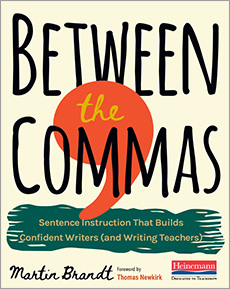Rethinking How We Teach Sentence-Building
Between the Commas: Sentence Instruction That Builds Confident Writers (and Writing Teachers)
By Martin Brandt
(Heinemann, 2019 – Learn more)
 Reviewed by Jeny Randall
Reviewed by Jeny Randall
“What are you reading?” my dentist asked when he came back to see if the Novocain had taken hold.
“A book about grammar and teaching writing,” I replied with some chagrin. I had slipped the book under my leg as I settled into the dentist chair and had pulled it out while waiting because Martin Brandt’s book Between the Commas is that engaging. It is, as one would expect of a book on writing instruction, well-written, but it is also funny, self-deprecating, inspiring, and yes, technical.
 Between the Commas grabbed my attention because I’d been reading Verlyn Klinkenborg’s Several Short Sentences About Writing in which the author states, “In school you learned to write as if the reader/Were in constant danger of getting lost, /A problem you were taught to solve not by writing clearly/But by shackling your sentences and paragraphs together” (p. 24).
Between the Commas grabbed my attention because I’d been reading Verlyn Klinkenborg’s Several Short Sentences About Writing in which the author states, “In school you learned to write as if the reader/Were in constant danger of getting lost, /A problem you were taught to solve not by writing clearly/But by shackling your sentences and paragraphs together” (p. 24).
Which forced me to reflect: Is the method of writing instruction that I’m using promoting bad habits in my students? How can I help them become stronger writers? Can I teach them to, as Klinkenborg tells us “Know what each sentence says, /What it doesn’t say,/ And what it implies” (3)?
Enter Between the Commas.
A framework for teaching writing
Using three pillars of sentence instruction – Sentence Focus, Sentence Development, and Sentence Coherence – Brandt lays out a framework for teaching writing, something he argues is typically lacking in programs preparing people to teach English, which focus instead on literature study.
His innovative and thoughtful approach provides friendlier names for free modifiers such as “the smack-talker” (noun phrase) and the “-ing bomb” (verbal phrase). He has also crafted a well-scaffolded series of activities that engage students in sentence combining, sentence scrambles, and sentence composition through modeling their own sentences on excerpts from published works.
While engaging, Between the Commas is also technical. I enjoy the puzzle of grammar, and I’ll admit to debating the Oxford comma for fun; however, there were moments when I had to downshift and re-read to fully understand the grammar lessons Brandt intersperses through the book.
Some readers may find reading the technical language and concepts a chore. That said, Brandt makes a compelling case that understanding different constructions leads to clear and confident writing for teachers and students alike.
I found myself reading Between the Commas on several layers. I began with an eye toward how I could develop additional strategies for teaching writing to my 6th grade Language Arts class. While some skills are better suited to older middle or high school students (Brandt teaches, among other things, AP language), there are ideas and tools in Between the Commas that I can use now.
Lots of exercises and resources – Brant’s and yours
Throughout the book Brandt includes exercises and resources (also available in digital form through the Heinemann website) that can be used immediately in the classroom. One that particularly stands out is his “Coherence model” which gives writers who “struggle with the problem of what to say next” (p. 102) a framework for how to expand their thinking.
While I look forward to using his sentence scramble exercises as a model, I will need to revise them to have simpler text for my younger students. Other resources include vocabulary lists and exercises to support students in including quotations into their work.
In addition, Brandt provides the steps needed for teachers to create their own exercises, simultaneously encouraging us to customize the exercises for our own classes and spurring us to mine our reading for sentences that are “not simply a grammatically sound mode of communication, but a pleasure to read” (p. xvii).
My fresh perspectives for writing at the sentence level
I also found myself reading Between the Commas as a writer, re-thinking what I’ve been taught, as Klinkenborg urged, in favor of writing at the sentence level. Brandt’s book has raised my awareness of sentence construction in both my reading and writing. I find myself pausing to appreciate and explore “smack-talkers” and “dime-droppers” as I read. And instead of spewing out a quick draft and going back to revise, I find myself re-working and combining sentences in an effort to reach greater clarity.
Brandt’s work also changes the way I read my students’ writing. He uses both excerpts from literature and samples of his students’ writing to illustrate his ideas. He not only respects his students, he delights in their language and stories. Brandt reminds us that his, and our, students’ “facility with language is deep and powerful, and worthy of our greatest respect” (p. 6). He invites us to read students’ work with an eye for the possible; to see how our students are poised to grow as grammarians and as thinkers.
Finally, I read as a fellow teacher. Brandt’s narrative vignettes invite us into his classroom to see not only what he teaches but how he teaches it. We hear the language he uses to encourage, support, and prod his students. And with similar language, he encourages, supports, and prods us.
Brandt inspires humility, reminding us that “our job as writing teachers is not to show how well we can edit for clarity, but to help our students achieve clarity themselves” (p. 25). He inspires us to approach writing instruction differently than we were taught, urging us to realize that “the true power of writing, as a tool for thought, happens when we write to find out what we have to say” (p. 99).
I am delighted to have found another mentor in writing instruction, and I look forward to revisiting Brandt’s irreverent wisdom in his future offerings.
Jeny Randall, a Responsive Classroom certified teacher, teaches 6th grade Language Arts and science at Saratoga Independent School in New York State. As Middle School Coordinator, she oversees the curriculum and program development for grades 6 – 8. Outside of school Jeny teaches yoga, reads whatever students send her way, and spends time with her family, outside if possible.



































“to help our students achieve clarity themselves” this idea is the basis for teaching not only language and literature but the entire school curriculum. The mission of teachers as mentors and educators.
The author has presented interesting ideas in this book, and you have described them no less interestingly.